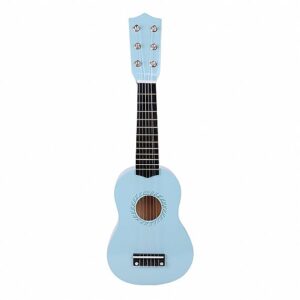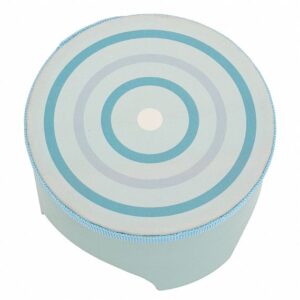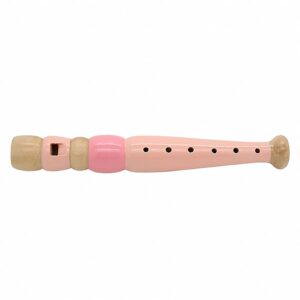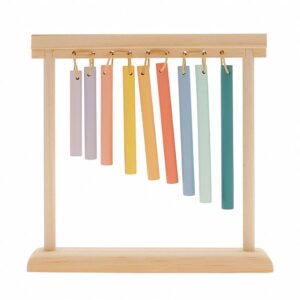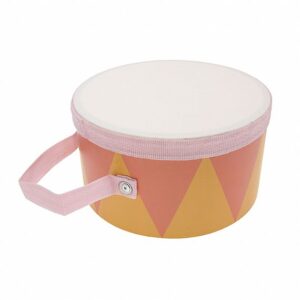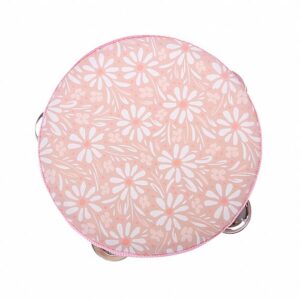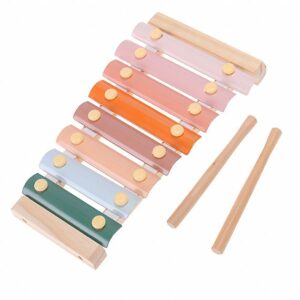What are wooden musical instruments?
Music is a universal language enjoyed around the world. Wooden music toys are a perfect introduction to music and give children the opportunity to experiment and express themselves with different instruments. Benefits to children include creating different sounds, tones and supporting the development of rhythm, calmness, listening, hand eye coordination and creativity. To build and instil confidence, your child will love you sitting down with them to make music together. As a family you could each choose an instrument, put some favourite music on and sing along.
Music teaches kids lots of skills. Learning to play music requires commitment and discipline and if you splash out on an instrument, you need to know your child is going to put time and effort into practicing their skills. Children can learn rhythm, beat, pattern recognition, and even math from music. Musical instruments for kids can also help to cultivate social skills while collaborating to make music together.
Parents rarely have to be convinced of the merits of teaching their children the alphabet or how to count, but adding music to their daily schedule can often be a stretch. But here’s the thing: there are SO many benefits to encouraging your child to learn to play music. But with so many musical instruments for kids how do you make the right pick?
To help you choose the right starter kit for your child, here is my list of the top musical instruments for kids.
Music Toys benefits for Kids
Music can benefit your child in many areas – language, maths, concentration and social skills, just to name a few! So whether or not your child learns a musical instrument, try to expose your child to music as much as possible and enjoy the many benefits!
Brain growth
Studies in neuroscience show that music can enhance brain function in children. Musical activities (such as playing an instrument, singing or just listening to music) stimulate the brain, and this brain workout leads to improved brain structure with the formation of new neural connections.
Language skills
Studies also show that young children who participate in music classes have improved speech development and learn to read more easily. Learning music helps to develop the left side of the brain (related to language and reasoning), assists with sound recognition, and teaches rhythm and rhyme. Songs can also help children remember information (just think of the Alphabet song!).
Maths skills
Music can help with the development of maths skills. By listening to musical beats your child can learn basic fractions, pattern-recognition and problem solving. Children who study music also have improved spatial intelligence and ability to form mental pictures of objects – skills that are important for more advanced mathematics.
Memory, attention and concentration
Recent studies have shown that people who are musically trained have better working memory skills, helping them to remember things even while their minds are busy with other matters – important aspects of mental arithmetic and reading comprehension. Learning music also requires significant levels of concentration, training children to focus their attention for sustained periods.
Increased coordination
Just like playing sports, playing and dancing to music helps children develop their motor skills. Making music involves more than the voice or fingers; you also use ears and eyes, as well as large and small muscles, all at the same time. This helps the body and the mind work together.
Achievement and discipline
Learning music teaches children to work towards short-term goals, develop routine and practice self-discipline. Setting aside regular time for practice develops commitment and patience. Mastering a new piece of music leads to a sense of pride and achievement, and helps children to learn the value of self-discipline.
Social skills
Making music with other people (like in a band or choir) improves children’s social and emotional skills. They learn to work together as a team and develop their sense of empathy with others. Researchers have found that when children play music together – from simple rhythms to larger group performances – they are better able to tune into other people’s emotions.
The joy of music
Music can give children a way to express themselves, to unleash their creativity, to be inspired and uplifted, to relax, and to relieve stress and tension. Just think about listening to a beautiful piece of classical music, singing along to a favourite song with friends, or dancing to a great song on the radio – music can make your heart sing!
Music for life
With all these benefits, try to expose your child to music as much as possible – listen to music together, sing songs, play rhythm games, go to concerts or make your own instruments together. Your local library, community centre or music society may offer music programs for kids. If your child wants to learn a musical instrument, your options may include a school music program, private music teachers, and group music activities such as choirs, recorder groups and bands.
What To Look For When Choosing The Best Musical Instruments For Kids
Choose the right musical instrument for your child will encourage them to learn to play the musical instrument; it boosts the love for music. Choosing the wrong musical instrument has the opposite effect. These features will help parents decide what is best for their little ones.
Best Drum Sounds For Preschoolers
The Toy solid wood drum is a simple toy, but one that is bound to become a firm favorite in any musical household. Give your child this toy as a gift and let them learn all about rhythm through play. The drum is kid-friendly enough for toddlers and pre-school children and when struck with the rubber-tipped drumstick, it emits a pleasant melodic sound.
Oval Xylophone
Infants and toddlers love hearing music and banging things to make noise. Xylophones are one of the classic music toys for 1-year-olds.The Oval Xylophone by Plan Toys make a great first music toy. This wooden xylophone has five colorful keys that each make a different tone when struck by a mallet. This fun activity promotes the understanding of cause-and-effect while proving motor skills practice. Keep little hands busy with the beautifully colorful instrument.
